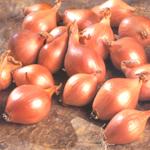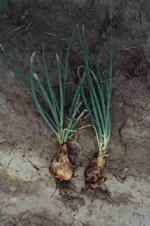| Fruits |
Vegetables
|
Shallot, Allium ascalonicum / Liliaceae (Alliaceae)
|
Note: Composition for 100 g. of fresh product Values in ( min. - max. ) format. | |

Shallots are quite unknown vegetables. The edible bulb is similar to the onion, but with cloves, like the garlic. It is a mix of the onion and the garlic taste, and it is highly appreciated in the high-class cooking due to its delicate and aromatic flavouring. It is not very nutritious; it supplies some minerals, such as phosphorus, fluorine and potassium.
Nutrition and eating
Shallots are considered mineralizers, appetizers and stimulating foodstuffs. They are mainly used for cooking, and they have few healing effects.
The fruit
 Shallots are quite unknown vegetables. The edible bulb is similar to the onion, but with cloves, like the garlic. It is a mix of the onion and the garlic taste, and it is highly appreciated in the high-class cooking due to its delicate and aromatic flavouring. It is not very nutritious; it supplies some minerals, such as phosphorus, fluorine and potassium.
Shallots are quite unknown vegetables. The edible bulb is similar to the onion, but with cloves, like the garlic. It is a mix of the onion and the garlic taste, and it is highly appreciated in the high-class cooking due to its delicate and aromatic flavouring. It is not very nutritious; it supplies some minerals, such as phosphorus, fluorine and potassium.Shallots, also known as scallion or Ascalonian onion, belong to the family of the Liliaceae, and the scientific name is Allium ascalonicum.
This plant bears an edible bulb of rounded or pear shape of approximately 3cm of diameter. Like onions, it consists of concentrive layers, but in this case the bulb is divided in cloves, like garlics.
Their taste is a mixture between garlic and onion, so it is used mainly as seasoning. It is mainly cultivated in Asia and North America. It is not very popular in Europe, although it is highly appreciated in France, where it is also used to aromatize white wines and red wine vinegar, apart from being the basic ingredient for multiple popular sauces. It is also consumed raw, in salads. It is an indispensable ingredient in many sauces of haute cuisine restaurants.
Concerning their nutritious value, they only supply significant amounts of minerals such as phosphorus, fluorine and potassium. It is low in calories, it mineralizes and it stimulates.
The plant

Shallots belong to the family of the Liliacease and their scientific name is Allium ascalonicum. They are very similar to onions. In the same way as onions, this plant forms a bulb, that shows a flattened mass in the base called disc, which is the stem. The leaves are arranged on it, joining in the lower part and forming the bulb. This is composed of independent small bulbs or cloves, as it happens in garlics. The upper side of the leaves is hollow, rounded and of green colour.
Unlike onions, shallots do not produce seeds, and therefore they are propagated through small bulbs.
Unlike onions, shallots do not produce seeds, and therefore they are propagated through small bulbs.
| Interempresas Media, S.L. / 2026 | [ Legal notice | Política de Protección de Datos | Política de cookies | Publicidad] |
